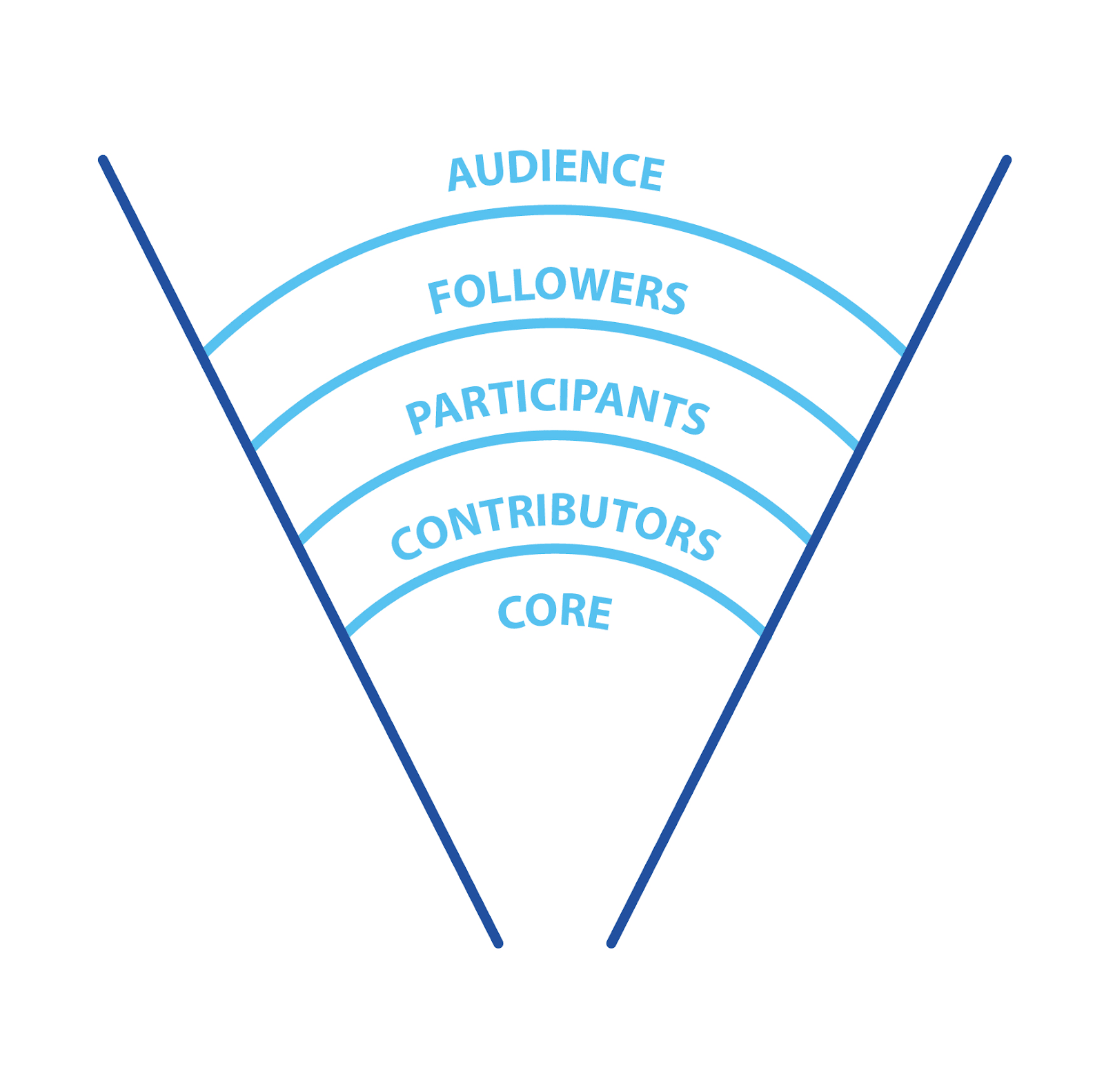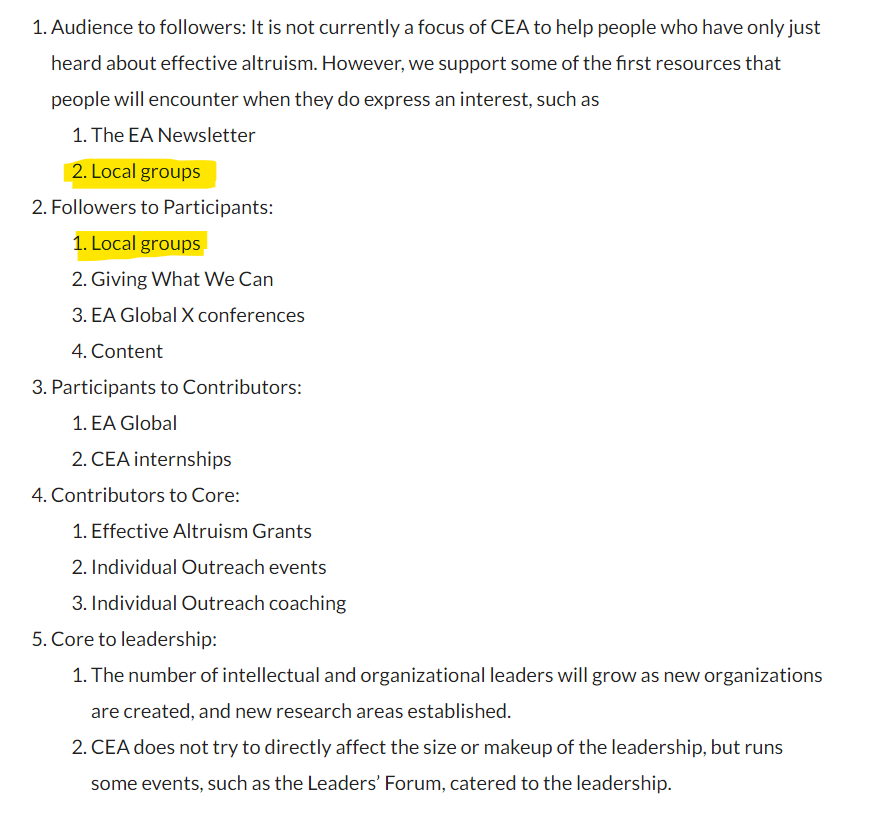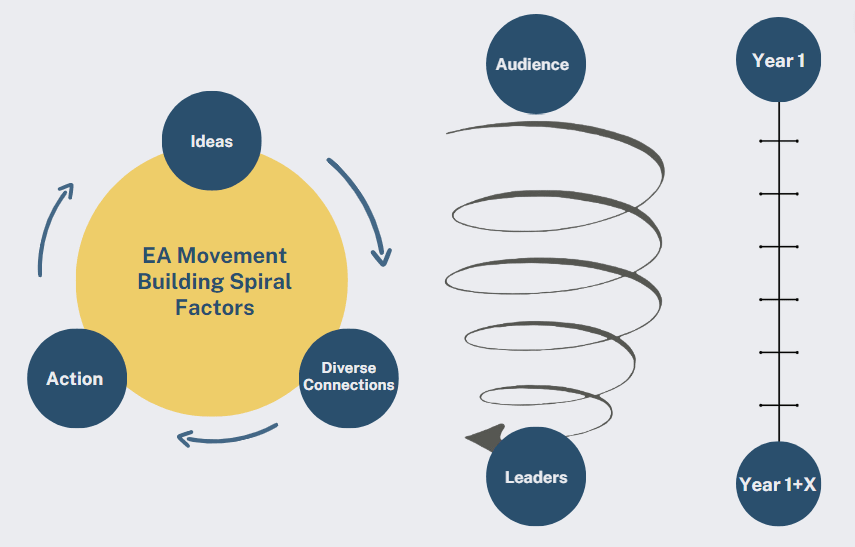Recently, there's been ongoing debate about the impact of EA community building. We're keen to question the current model and present some supportive case studies (epistemic status: case studies). Our group, being nationally organized, funded, and focused on action, has developed a model that varies somewhat from the standard. We've seen positive results over the years, were considered one of the stronger groups by CEA and presented our model at last year's London EAG. Now, we plan to publish an updated version of our ideas, complemented by stories of projects and people from our community. This will serve as a learning resource for other groups to refine and enhance their city or national setups.
CEA uses the funnel model to describe their work, where they try to bring potential EAs from being part of the audience all the way to becoming leaders in the movement. Beyond explaining CEA’s work, the model also tries to answer the key question of movement building - how can we get people to meaningfully contribute to the world’s most pressing problems?

They mention local groups as working at the entrance to the funnel: moving people from audience to followers, and followers to participants.

We’d like to question the idea that professional city and national groups (C&N groups) and university groups can be lumped together in the same category, and to show that C&N groups deserve credit for more than just two appearances in the funnel. While we agree that university groups are great for outreach, C&N groups also provide unique opportunities to help people contribute to solving the world's most pressing problems, by providing:
- Continuous contact points: sustained engagement with a diverse group, over an extended period of time, helps people become contributors, core members and leaders
- Supporting action: operating as an formal nonprofit can provide high value to members by incubating and supporting projects
To illustrate this, we’ll highlight some of the things we’ve done in Israel and the journeys of some of our community members. Some caveats are required: these are all stories, and don’t capture either the full impact of our work or reflect its cost-effectiveness, which is harder to assess. They are also (obviously) success stories, although we did try to highlight cases where EA Israel’s counterfactual impact and unique value-add was relatively clear. There are many other stories where EA Israel wasn’t able to provide value to members or potential members looking to increase their impact, or cases where we’re not aware of the impact we had, which we didn’t share here. These are also all from Israel, since that’s what we know best, but there are similar things going on in New York, Sweden, DC, Switzerland, Australia, Germany, Netherlands and other locations around the world.
Continuous contact points: a spiral, not a funnel
The funnel model implies that individuals ascend from one level to another in a linear series of jumps. According to the model, attending an EAG event, for example, moves you from participant to contributor.[1] However, from what we hear from our community members, their growth in the movement is more of a continuous process, facilitated by active participation in a group, with numerous opportunities to learn, connect with others who share your values, and take gradually more meaningful action.
Let’s take a look at some case studies:
- Shay is finishing his PhD in Mathematics, and will soon be working full time on AI alignment, with support from the EA ecosystem. For him, the community was especially important as a place to meet people who encouraged him to take a route different from his peers: instead of joining a cyber startup, he paused his PhD to try and integrate AI tools into the Israeli healthcare system, something that he thinks wouldn’t have happened without the support and encouragement of the EA Israel community. Having friends and a peer group that thinks his choice to maximize impact over profit is admirable, rather than crazy, changed his thinking. He wrote a forum post describing his decision making process at the time.
- Ido recently raised a successful seed round for his earn-to-give startup, and for him, the EA Israel community was crucial for his trajectory. In his words (translated and lightly edited):
“At a high level, I feel that the community was super impactful to me. Being introduced to EA and having people to talk to about the process really changed the way I thought. For a long time I looked for something I could do direct work on, went to EAGs searching for projects, and got a lot of support from the EA Israel community while I was looking. Within the EA Israel community there were people I could ask questions and get materials and introductions from, there were peers that validated my feelings that this is something worthwhile to spend my life on.
And finally there was a chance to “represent EA” which helped me internalize the values even more. It’s super easy to “softly believe in the right thing”, but to jump from that to actually living that way was much easier when there were steps on the way: attending a conference with other EA Israel members, leading an intro crash course at the encouragement of the community builders and volunteering on various projects. All of these are chances to actually become that person, instead of just talking about the ideas. I didn’t know of EA before I met the community, and the process of slowly becoming more and more active in the community, along with the people in the community, is what helped me today make my most important life decisions based on EA ideas and values.”
- Omer is one of the founders of Probably Good, a growing EA impact focused career advice organization, and was a founding member of EA Israel. At the time Omer was a successful entrepreneur, and helped start out EA Israel, but he wasn’t involved with EA in his day-to-day. Being part of the EA Israel community gave Omer the opportunity to try out small projects: he launched EA Israel’s career consulting service as a side project, and as a result of having the chance to pilot a career advice service and understand the needs of advisees firsthand, he ultimately co-founded Probably Good. Today, he manages an impact-focused team at Google using ML to forecast wildfires, as well as serving as the Chairman of the Board of EA Israel and leading Probably Good.
- Gidi says:
“Since I was 13 years old, I was interested in prioritizing my career path by impact, but couldn’t find anything like EA back then. When I was introduced to EA through the group that started EA Israel, I realized I could’ve used much better frameworks for my career plan, and EA gave me both the tools and the words for what I was pursuing.
I started as a volunteer, which later led to a paid role as the director of EA Israel for 2.5 years, during which I worked on several movement-wide projects focused on community-building strategies, user experience, and messaging.
During this time, I received the guidance and support of many EAs in building what later became an impact-oriented startup, using AI to shift the field of personal growth toward effectiveness and evidence. Both my startup and my EA projects were entirely the result of my gradual involvement with my local group.” - The Israel AI Safety Group - Vanessa, Itay, Yonatan, Nadav, and more - EA Israel connects between the high number of Israeli cyber and ML professionals interested in AI safety, and manages a hub (coworking space) where individuals can come together and collaborate on alignment and policy issues. Some members include Itay, who launched Mentaleap, an AI Safety research group; Yonatan, who’s a software developer now working full time on AI Safety; Vanessa, an alignment researcher with MIRI; Nadav who posts on the AI Alignment Forum; and many others (27 members active in the Slack, it’s our fastest growing channel). As of today, EA Israel supports the group by making connections between individuals interested in the field, facilitating the space that serves as the meeting point, curating the slack and whatsapp groups, and is exploring new ways to expand and increase the impact of the group.
Instead of a funnel, this looks more like a hits-based approach to helping people find their path impact, where sustained interaction enables members to make personal breakthroughs and deepen their engagement. It also takes time, and can play out over a few years, and community members can be involved and encouraged through multiple crossroads - graduation, graduate studies, first job, second job, and so forth. Although engagement levels change over time, the natural exit point of a university group - graduation - isn’t relevant to a C&N group.
Being involved in projects and taking gradually more meaningful action also seems to be a key driver of community building’s long-term impact, which is why we focus on it in our volunteer-oriented model of community building. Finally, participating in a community of people with different levels of experience helps people find the network and guidance that enables them to develop their ability to have impact (think EAG in your neighborhood, or 80k 1-1s with people who understand your context).

Supporting action
Our group doesn’t only act as an entrance point to EA, but helps members plan and implement high-impact careers, launch projects and donate based on EA principles. A group that operates as an independent nonprofit enables it to go beyond intro fellowships. Our ability to operate over longer time periods; our positioning as a nonprofit that can engage with other philanthropists, think tanks, and government institutions in our region; the size and diversity of our network; and the professional operations - all enable us to support to new projects or new organizations, incubate projects in-house, and impart guidance and advice to people looking to take significant action.
One of the things that enabled us to reach this stage was being able to transition from a strong group of volunteer founders to paid organizers, since the founding volunteers are all very busy and were unable to sustain their level of engagement over time. Like many EA groups, we also struggled with transition periods, but in the end we were able to maintain our organizational structure and the momentum of the group beyond the availability of the founding members, instead of winding down and maybe relaunching sometime in the future.
To make this more concrete, let's look at some examples from community members who were supported by EA Israel.
Case studies:
- Dan, along with Sella, launched an accredited university course based on EA ideas, one of the only ones in the world. The course got great feedback, rating as the top course in the university based on participants feedback. To build on the success, they received a grant to scale the project and produce a Massive Online Open Course that would transform the course into an online asset that could be used by tens of thousands of people worldwide. EA Israel serves as the financial and legal entity for the project and helped contribute to the successful conclusion of the operations needed to launch the MOOC.
- Noam participated in an EA Israel intro fellowship, which we ran at a local university. Our fellowships are a bit different, since they include one semester of learning and discussion and one semester of working on a project to implement what they’ve learnt. Noam’s project was to run outreach events at her university, and in a few months had organized 3 events with over 100 participants, enough for her to receive a substantial Open Phil grant to found and run the EA-TAU group. EA Israel staff encouraged and supported the group along the way - including assistance with the grant application, supporting a series of professionally facilitated career workshops with , and providing regular meetings and operational support, such as serving as a fiscal sponsor for the group.
- David is the founder of ALTER - the Association for Long Term Existence and Resilience, an academic research and advocacy organization, based in Israel, which hopes to investigate, demonstrate, and foster useful ways to improve the future in the short term, and to safeguard and improve the long-term trajectory of humanity. Founding a new nonprofit in Israel isn’t easy, and EA Israel supported David and the team significantly along the way: by running ALTER’s first hiring round, advising on legal and operational issues, providing operational support for the first AI Safety conference in Israel, and assisting with some technical financial things that are both boring and crucial for an organization to survive and grow.
- My (Ezra’s) story also showcases the uniqueness of the EA Israel group. While working in the strategy department of a government agency, I felt I wasn’t maximizing my impact and ended up doing career consulting with EA Israel and signing up for a volunteer project. While working on the project, I was very impressed by the professionalism of the group, and when EA Israel received additional funding and offered me to join as COO, I felt that getting more involved with EA Israel was exciting and would increase my career capital. During my time as a staff member, I led the Maximum Impact project - a project incubated in-house that is publishing the first cost-effectiveness analyses on Israeli nonprofits and engaging with Israeli philanthropy to make it more evidence-based. I’m currently working on launching an Israeli Effective Giving website to enable Israelis to donate tax-deductible to top rated nonprofits (GiveWell, etc). Both projects required significant continuity and operational support.
Closing remarks
These stories illustrate some of the less-discussed ways a group can make an impact. The organization offers continuous contact points, provides guidance and operational assets, supports action, facilitates connections, events and projects, and offers a sense of direction and purpose to the community. We’ve been able to build and then harness a sense of momentum: talented people who want to join the community because of the sense that amazing things are happening and lots of talented people are involved, something that we’re hoping won’t be affected by the post-FTX funding situation.
We hope that this helps people think differently about movement building and the role of C&N groups, and that our stories can inspire other groups or group members. We’re always looking for new projects and new ways to leverage our organizational assets to provide value, so please reach out if you have any ideas, comments or questions.
- ^
I’ve recently had some discussion with CEA staff members who seem to agree with the “multiple touchpoints and action” theory, so I don’t think the “funnel model” actually represents their current thinking

Thanks for clarifying that national groups fulfil important roles beyond those two parts of the funnel!
Reading this made me realise I'm worried that there are important things that regional/national groups do that aren't always very legible to funders, like:
I'm worried that various contributions of national groups are hard to capture in a metric like 'longtermist career changes', and think this post is helpful in clarifying the importance of funders not being too myopic in their grantmaking decisions. [Edit: I'm not necessarily arguing they are] Thanks for writing this!
I've been thinking along the same lines but wouldn't have verbalised it as well as you. Thank you for writing this up!
I assume that especially in countries with less EA presence of direct impact orgs, the local EA communities can play an vital role in supporting people to get more engaged with EA ideas and potentially become leaders of their own high-impact projects.
I thought having many different forms of engagement at each stage was implicit to the funnel model as well, but having it explicit as "action, ideas, and diverse connections" seems like a useful framework. I'll think more about what this could mean in practice for us in my group
Thank you for wiring this down, the work of EA Israel has been inspiring for us at EA Germany.
I agree, thanks a lot Ezra! This is super interesting to read, and a great summary of my still vague impression of what our national group is able to offer to the many local groups scattered throughout Germany.